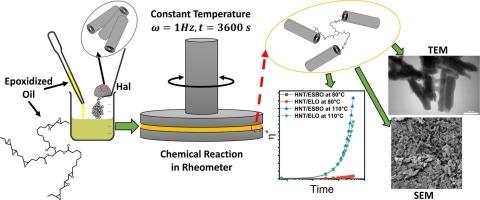高岭土纳米管的生物基功能化:流变动力学和环氧亚麻油和大豆油的表面改性
IF 5.8
2区 地球科学
Q2 CHEMISTRY, PHYSICAL
引用次数: 0
摘要
高岭土纳米管(Hal)是聚合物工业中最重要的填料之一;尽管如此,它们与疏水聚合物的不相容性一直是一个挑战。研究了环氧亚麻油(ELO)和环氧大豆油(ESBO)对Hal的直接改性,重点研究了反应温度对改性效率和动力学的影响。采用不同的技术监测了ELO和ESBO中的氧烷基团与Hal上的羟基之间的化学相互作用。流变动力学测量表明,随着温度的升高,储存模量显著增加,表明Hal和油之间形成了交联网络。反应动力学遵循Arrhenius-type行为,esbo修饰的Hal的活化能(15.50 kJ/mol)低于ELO (16.06 kJ/mol)。化学评估证实,在高温下,内部羟基减少,羰基增加,而热研究显示,质量损失逐渐增加,表明成功的功能化。显微镜显示两种油改性后Hal的形态变化,ESBO表现出更高的反应活性,尽管其环氧含量较低。本研究提出了一种新的方法来修饰Hal,同时突出了温度的影响。这些发现为增强hal基聚合物复合材料的性能提供了可持续的策略。本文章由计算机程序翻译,如有差异,请以英文原文为准。

Bio-based functionalization of halloysite nanotubes: Rheokinetics and surface modification with epoxidized linseed and soybean oils
Halloysite nanotubes (Hal) are among the most important fillers in the polymer industry; nonetheless, their incompatibility with hydrophobic polymers has been challenging. This study investigates the direct modification of Hal using epoxidized linseed oil (ELO) and epoxidized soybean oil (ESBO), focusing on the impact of reaction temperature on functionalization efficiency and kinetics. The chemical interaction between the oxirane groups in ELO and ESBO, and hydroxyl groups on the Hal was monitored using different techniques. Rheokinetics measurements demonstrated a significant increase in storage modulus with temperature, indicating the formation of a crosslinked network between Hal and oils. The reaction kinetics followed an Arrhenius-type behavior, with ESBO-modified Hal exhibiting a lower activation energy (15.50 kJ/mol) than ELO (16.06 kJ/mol). Chemical assessment confirmed a reduction in inner hydroxyl groups and an increase in carbonyl groups at elevated temperatures, while thermal studies revealed a progressive increase in mass loss, indicative of successful functionalization. Microscopy showed morphological changes in Hal upon modification with both oils, with ESBO depicting a higher reactivity despite its lower epoxy content. This study presents a novel approach to modifying Hal while highlighting the influence of temperature. These findings provide sustainable strategies for enhancing the performance of Hal-based polymer composites.
求助全文
通过发布文献求助,成功后即可免费获取论文全文。
去求助
来源期刊

Applied Clay Science
地学-矿物学
CiteScore
10.30
自引率
10.70%
发文量
289
审稿时长
39 days
期刊介绍:
Applied Clay Science aims to be an international journal attracting high quality scientific papers on clays and clay minerals, including research papers, reviews, and technical notes. The journal covers typical subjects of Fundamental and Applied Clay Science such as:
• Synthesis and purification
• Structural, crystallographic and mineralogical properties of clays and clay minerals
• Thermal properties of clays and clay minerals
• Physico-chemical properties including i) surface and interface properties; ii) thermodynamic properties; iii) mechanical properties
• Interaction with water, with polar and apolar molecules
• Colloidal properties and rheology
• Adsorption, Intercalation, Ionic exchange
• Genesis and deposits of clay minerals
• Geology and geochemistry of clays
• Modification of clays and clay minerals properties by thermal and physical treatments
• Modification by chemical treatments with organic and inorganic molecules(organoclays, pillared clays)
• Modification by biological microorganisms. etc...
 求助内容:
求助内容: 应助结果提醒方式:
应助结果提醒方式:


